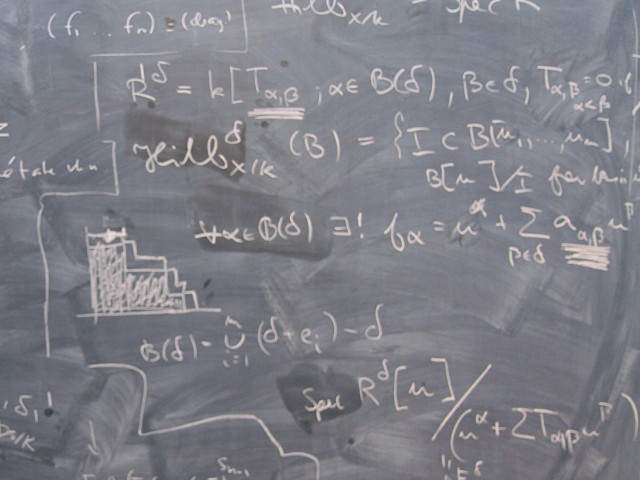- Exempel på optimeringstillämpningar och formuleringsträning.
- Grundläggande begrepp och teori för optimering, speciellt teori för konvexa problem.
- Linjär algebra i Rn, speciellt baser för de fyra fundamentala underrum motsvarande en given matris, samt LDLT-faktorisering för symmetriska positivt semidefinita matriser.
- Linjär optimering, inklusive dualitetsteori.
- Optimering av flöden i nätverk.
- Kvadratisk optimering med linjära bivillkor.
- Linjära minsta-kvadratproblem, speciellt minsta-normlösningar.
- Ickelinjär optimering utan bivillkor, speciellt ickelinjära minsta-kvadratproblem.
- Optimalitetsvillkor för ickelinjär optimering med bivillkor, speciellt för konvexa problem.
- Lagrangerelaxering
SF1811 Optimeringslära 6,0 hp

SF1811 är en grundläggande kurs om optimeringslära.
Information per kursomgång
Information för HT 2025 Start 2025-10-27 programstuderande
- Studielokalisering
KTH Campus
- Varaktighet
- 2025-10-27 - 2026-01-12
- Perioder
HT 2025: P2 (6 hp)
- Studietakt
33%
- Anmälningskod
50285
- Undervisningsform
Normal Dagtid
- Undervisningsspråk
Engelska
- Kurs-PM
- Antal platser
Ingen platsbegränsning
- Målgrupp
- Ingen information tillagd
- Planerade schemamoduler
- [object Object]
- Schema
- Del av program
Civilingenjörsutbildning i energi och miljö, åk 3, MHI, Villkorligt valfri
Civilingenjörsutbildning i energi och miljö, åk 3, HSS, Villkorligt valfri
Civilingenjörsutbildning i energi och miljö, åk 3, RENE, Villkorligt valfri
Civilingenjör och lärare, åk 5, TEDA, Villkorligt valfri
Civilingenjörsutbildning i energi och miljö, åk 3, SMCS, Villkorligt valfri
Civilingenjörsutbildning i energi och miljö, åk 3, KEM, Villkorligt valfri
Civilingenjör och lärare, åk 4, MAFY, Villkorligt valfri
Civilingenjörsutbildning i energi och miljö, åk 3, MES, Villkorligt valfri
Civilingenjörsutbildning i energi och miljö, åk 3, SUE, Villkorligt valfri
Civilingenjör och lärare, åk 4, TEDA, Villkorligt valfri
Civilingenjörsutbildning i energi och miljö, åk 3, SUT, Villkorligt valfri
Masterprogram, datalogi, åk 2, CSDA, Rekommenderad
Civilingenjör och lärare, åk 5, MAFY, Villkorligt valfri
Masterprogram, tillämpad matematik och beräkningsmatematik, åk 1, Valfri
Masterprogram, maskininlärning, åk 1, Villkorligt valfri
Civilingenjörsutbildning i teknisk matematik, åk 3, Obligatorisk
Masterprogram, maskininlärning, åk 2, Villkorligt valfri
Kandidatprogram, informations- och kommunikationsteknik, åk 3, Rekommenderad
Masterprogram, systemteknik och robotik, åk 2, Rekommenderad
Masterprogram, systemteknik och robotik, åk 1, Rekommenderad
Civilingenjörsutbildning i industriell teknik och hållbarhet, åk 3, Obligatorisk
Masterprogram, tillämpad matematik och beräkningsmatematik, åk 2, Valfri
Kontakt
Kursplan som PDF
Notera: all information från kursplanen visas i tillgängligt format på denna sida.
Kursplan SF1811 (HT 2019–)Innehåll och lärandemål
Kursinnehåll
Lärandemål
Efter genomgången kurs ska studenten för att erhålla ett godkänt betyg kunna
- Tillämpa grundläggande teori, begrepp och metoder inom de delar av optimeringslära som beskrivs av kursinnehållet för att lösa problem
- Formulera förenklade tillämpningsproblem som optimeringsproblem och lösa med programvara
- Läsa och tillgodogöra sig matematisk text om exempelvis linjär algebra, analys och optimering samt deras tillämpningar, kommunicera matematiska resonemang och beräkningar inom detta område muntligt och skriftligt på ett sådant sätt att de är lätta att följa.
För högre betyg ska studenten även kunna
- Förklara, kombinera och analysera grundläggande teori, begrepp och metoder inom de delar av optimeringslära som beskrivs av kursinnehållet
Kurslitteratur och förberedelser
Särskild behörighet
Slutförd kurs i SF1624 Algebra och geometri eller SF1672 Linjär Algebra.
Slutförd kurs i SF1626 Flervariabelanalys eller SF1674 Analys i fler variabler.
Slutförd kurs i Numerisk analys SF1511, SF1519, SF1545 eller SF1546.
Kurslitteratur
Kurslitteraturen anges på kursens hemsida senast 4 veckor innan kursstart.
Examination och slutförande
Betygsskala
Examination
- INL1 - Inlämning, 2,0 hp, betygsskala: P, F
- TEN2 - Tentamen, 4,0 hp, betygsskala: A, B, C, D, E, FX, F
Examinator beslutar, baserat på rekommendation från KTH:s handläggare av stöd till studenter med funktionsnedsättning, om eventuell anpassad examination för studenter med dokumenterad, varaktig funktionsnedsättning.
Examinator får medge annan examinationsform vid omexamination av enstaka studenter.
När kurs inte längre ges har student möjlighet att examineras under ytterligare två läsår.
Examinator beslutar, i samråd med KTH:s samordnare för funktionsnedsättning (Funka), om eventuell anpassad examination för studenter med dokumenterad, varaktig funktionsnedsättning. Examinator får medge annan examinationsform vid omexamination av enstaka studenter.
Examinator
Etiskt förhållningssätt
- Vid grupparbete har alla i gruppen ansvar för gruppens arbete.
- Vid examination ska varje student ärligt redovisa hjälp som erhållits och källor som använts.
- Vid muntlig examination ska varje student kunna redogöra för hela uppgiften och hela lösningen.